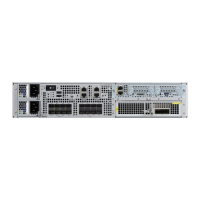Configuring NRZI Format
All EIA/TIA-232 interfaces on the 4-Port Serial Interface SPA support non-return-to-zero (NRZ) and
non-return-to-zero inverted (NRZI) formats. Both formats use two different voltage levels for transmission.
NRZ signals maintain constant voltage levels with no signal transitions—no return to a zero voltage
level—during a bit interval and are decoded using absolute values: 0 and 1. NRZI uses the same constant
signal levels but interprets the absence of data—a space—at the beginning of a bit interval as a signal transition
and the presence of data—a mark—as no signal transition. NRZI uses relational encoding to interpret signals
rather than determining absolute values.
Use the following commands when configuring NRZI format:
PurposeCommand
Enters global configuration mode.Router# configure terminal
Selects the interface to configure and enters interface
configuration mode.
Router(config)# interface serial slot/subslot/port
Enables NRZI encoding.Router(config-if)# nrzi-encoding
Disables NRZI encoding.Router(config-if)# no nrzi-encoding
Configuring Cyclic Redundancy Checks
Cyclic redundancy checking (CRC) is an error-checking technique that uses a calculated numeric value to
detect errors in transmitted data. All interfaces use a 16-bit CRC (CRC-CITT) by default but also support a
32-bit CRC. The designators 16 and 32 indicate the length (in bits) of the frame check sequence (FCS). The
sender of a data frame calculates the frame check sequence (FCS). Before it sends a frame, the sender appends
the FCS value to the message. The receiver recalculates the FCS and compares its calculation to the FCS from
the sender. If there is a difference between the two calculations, the receiver assumes that a transmission error
occurred and sends a request to the sender to resend the frame.
To set the length of the cyclic redundancy checks (CRC), use the following commands:
PurposeCommand
Enters global configuration mode.Router# configure terminal
Selects the interface to configure and enters interface
configuration mode.
Router(config)# interface serial slot/subslot/port
Specifies the length of the CRC, where:
• 16—Specifies a 16-bit length CRC. This is the
default.
• 32—Specifies a 32-bit length CRC.
To set the CRC length to the default value, use the
no form of this command.
Router(config-if)# crc {16 | 32}
Cisco ASR 1000 Series Aggregation Services Routers SIP and SPA Software Configuration Guide, Cisco IOS XE
Everest 16.5
OL-14127-17 285
Configuring the 4-Port Serial Interface SPA
Optional Configurations

